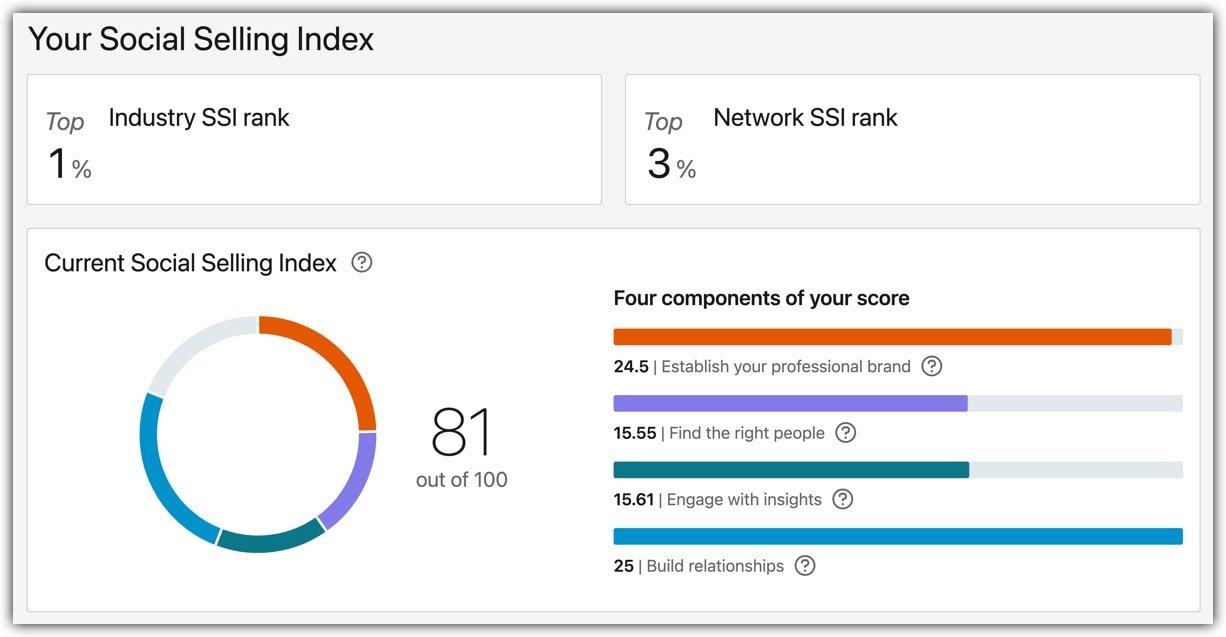Here’s a quick look at LinkedIn Social Selling Index (SSI) – the score that LinkedIn uses to reflect the strength of your presence on the platform.
- What is LinkedIn SSI?
- How do I see my LinkedIn SSI score?
- What do the LinkedIn SSI scores mean?
- How do I increase my LinkedIn SSI score?
- Keep your SSI score in perspective
- Let’s wrap up
What is LinkedIn SSI?
SSI is LinkedIn’s measure of the strength of your profile and presence.
SSI is scored from 0 to 100, in 4 categories each worth 25 points. The categories are:
Establish your professional brand.
LinkedIn’s description: “Complete your profile with the customer in mind. Become a thought-leader by publishing meaningful posts.”
Find the right people.
LinkedIn’s description: “Identify better prospects in less time using efficient search and research tools.”
Engage with insights.
LinkedIn’s description: “Discover and share conversation-worthy updates to create and grow relationships.”
Build relationships.
LinkedIn’s description: “Strengthen your network by finding and establishing trust with decision makers.”
How do I see my LinkedIn SSI score?
You can look up your SSI score here:
Here’s mine (this changes often):

What do the LinkedIn SSI scores mean?
Here’s my unofficial guide to what your SSI score means.
| Score | What it means |
|---|---|
| 0–39 | You probably don’t use LinkedIn much or at all. |
| 40–49 | You’ve completed your profile and know the basics. |
| 50–59 | You probably comment and post your own content. |
| 60–69 | You’re doing well on all counts. You’re good at LinkedIn. |
| 70–79 | You’re way above average. People should follow your example. |
| 80–89 | You’re in LinkedIn’s good books. You probably have lots of followers. |
| 90–99 | You’re a LinkedIn superstar or have unholy powers. |
| 100 | You know how to use Photoshop. You have issues. |
Scores become academic above 70.
If your score goes above 70, well done. You can pretty much stop worrying about it at this stage.
How do I increase my LinkedIn SSI score?
There’s no magic formula but try the following:
- Complete all the fields on your profile.
- Comment on other people’s content.
- Post your own content.
- Get involved in direct message conversations.
- Join and be active in LinkedIn Groups (I hate Groups so I don’t do this myself).
If you haven’t seen them already, my free LinkedIn starter guide and LinkedIn engagement guide are good places to look for tips on improving your LinkedIn presence (and your SSI).
Keep your SSI score in perspective.
Your SSI is not a guarantee of getting leads or business. And it isn’t a reflection of your personal worth.
Your score can change if you upgrade to a paid LinkedIn package. Is that really objective?
Also, it seems that the score is relative to the strength of your network, meaning that connecting with more powerful, “important” people could see your score go down. Conversely, connecting with a lot of much less important people could increase your score.
Remember the old saying: if you’re the smartest person in the room, you need to be in a different room.
All that said, LinkedIn SSI can still be a useful way to track your overall progress on LinkedIn, especially when you first get started and your score is below 40. This sort of gamification of scoring is a good way to get new users up to speed quickly.
Let’s wrap up.
Your LinkedIn SSI score is good to know but don’t be too attached to it.
There are more useful measures of how well you’re doing on LinkedIn, such as how many people you engage in conversations with and how many times your profile has been viewed.


